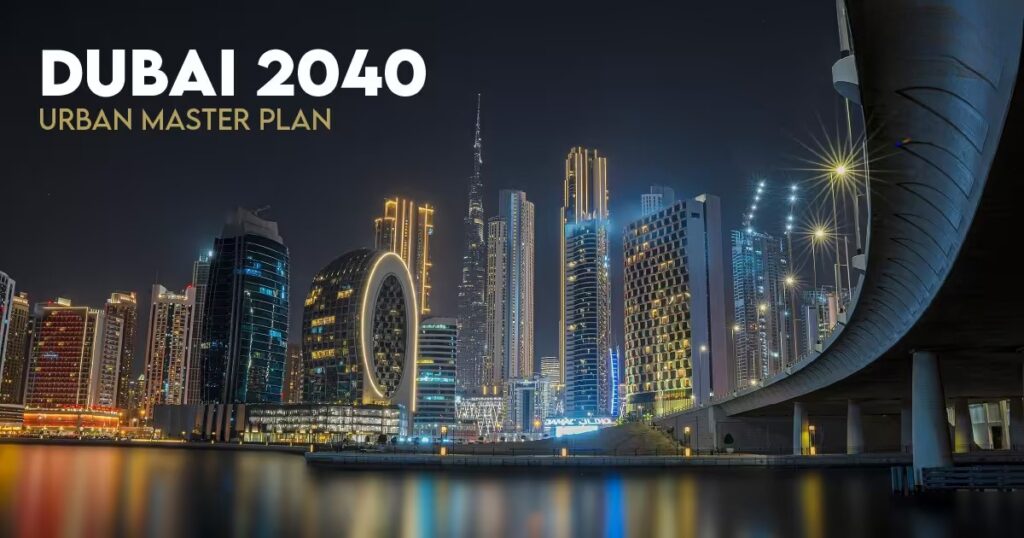Dubai 2040 Urban Master Plan: Shaping the Future of Dubai
Dubai is no stranger to ambitious visions. From towering skyscrapers to futuristic transport, the city always aims high. The Dubai 2040 Urban Master Plan is the latest long-term strategy that charts Dubai’s urban, social, and environmental future through to 2040. Its goals are expansive—creating vibrant, inclusive communities; improving mobility; doubling green and leisure areas; heightening sustainability; and preserving heritage—all while accommodating a growing population and evolving economy.
What is the Dubai 2040 Master Plan?
Initially launched in 2021, this initiative represents Dubai’s seventh comprehensive urban plan since 1960. Over the decades, each plan has reflected the city’s evolving ambitions; however, this latest version goes even further. It now serves as a structural guide for all urban development, seamlessly integrating various sub-plans while simultaneously aligning with the emirate’s broader economic and social priorities.
By Dubai 2040 Urban Master Plan aims to serve an expected resident population of about 5.8 million, and a daytime population rising to around 7.8 million.
Key Objectives & Features
Here are the major goals and the transformative features embedded in the plan:
- Upgrade urban centres: Certain areas like Deira & Bur Dubai, Downtown & Business Bay, Dubai Marina & JBR are to be modernised, while two new centres—Expo 2020 Centre and Dubai Silicon Oasis Centre—will be developed to host exhibitions, tourism, technology, and logistics.
- Green spaces & environmental sustainability: Green and leisure areas, public parks are to double in size; nature reserves and rural natural areas will form 60% of Dubai’s total land-area. Green corridors will connect residential, work, and service zones enabling better pedestrian & cycling networks.
- Public beaches & coastal areas: The length of public beaches is expected to increase dramatically—up to 400% expansion—giving more recreational access to waterfronts.
- Education & Health Facilities: Land areas for education and health to rise by about 25% to ensure a growing population has adequate services.
- Mobility & 20-Minute City Concept: One of the most compelling ideas within the plan is the principle that 80% of daily, ordinary needs should be met within just 20 minutes — whether by walking, cycling (soft mobility), or using public transit. Moreover, the plan aims to increase population densities around key transit stations, thereby encouraging greater use of mass transit. In addition, it focuses on building integrated service centres to ensure that essential amenities are always accessible and efficiently connected. Ultimately, this approach supports Dubai’s broader vision of creating a more sustainable, connected, and people-friendly urban environment.
- Use of existing urban space & infrastructure efficiency: The plan emphasises developing within current city limits, utilising under-used lands, improving infrastructure efficiency rather than unchecked sprawl.
- Cultural / Heritage Preservation: Dubai wants to safeguard its cultural and urban heritage; preserving older neighborhoods, historic landmarks, and strengthening citizens’ attachment to heritage areas.
Impacts & Outcomes by 2040
Given these objectives, the plan projects a number of concrete outcomes by 2040:
- Green and recreational spaces will double in size.
- Nature reserves and rural natural areas cover 60% of the emirate’s land.
- Commercial land area will increase, and land used for hotels/tourism will also grow significantly.
- Public beaches are to expand by 400%.
- More accessible healthcare and education for the growing population.
Why It Matters
This plan is more than urban expansion—here’s why it’s significant:
- Sustainability First: In a world rising up to climate challenges, Dubai 2040 Urban Master Plan is committing to more green spaces, nature corridors, sustainable mobility, and reduced resource wastage. That can improve air quality, urban heat, and quality of life.
- Liveability & Well-Being: With amenities, parks, health & education, plus the “20-minute city”, the idea is that residents spend less time commuting and more time living. A city where daily needs are nearby adds up to better mental and physical well-being.
- Economic Opportunity: Furthermore, the anticipated growth in tourism, commercial hubs, innovation centres, and new real estate developments will continue to open vast opportunities for investment, job creation, and long-term economic diversification. As a result, areas located around major transit corridors are likely to experience increased value and heightened demand. In turn, this dynamic growth will reinforce Dubai’s position as a global hub for business, innovation, and sustainable urban development.
- Preserving Identity: Balancing modernization with heritage ensures that Dubai doesn’t lose its cultural fabric amid change.
Challenges & Considerations
No plan is perfect, and implementation will face obstacles. Some considerations:
- Infrastructure strain: As population increases, ensuring that water, power, transport, and waste systems keep pace will be crucial.
- Cost & Funding: However, funding large-scale expansion and green projects will inevitably be expensive. Therefore, maintaining a careful balance between public and private investment becomes crucial. Moreover, successful collaboration between government entities and private sector partners will determine how effectively these ambitious projects are implemented and sustained over time.
- Balancing density & comfort: Increasing density around transit is good for mobility but needs careful design to avoid overcrowding or loss of quality.
- Environmental Risks: Coastal areas are sensitive; green corridors must be protected. Also, ensuring that growth does not come at the cost of ecosystems is key.
What This Means for Residents & Investors
For someone living in or considering moving to Dubai, or investing in property:
- Seek areas near major transit stations—they’ll likely benefit most from the plan.
- Properties in or near new or upgraded urban centres (like Expo City or Silicon Oasis) may gain in value.
- Amenities and green/recreational spaces will be more accessible in many areas.
- Expect more public beaches, parks, and leisure offerings in coming years.
- Real estate demand will shift: more interest in mid-density, transit-oriented, sustainable housing.
Conclusion
Dubai’s 2040 Urban Master Plan is an ambitious blueprint—one that aims not just for growth, but for growth with balance. It seeks to position Dubai as a city that’s sustainable, inclusive, and more livable, while preserving heritage and identity. If the city achieves even a fraction of what it sets out, by 2040 Dubai will have not only grown in population and economic might, but also in quality of life, identity, and global appeal. For residents and investors alike, the opportunities will be real and varied.

